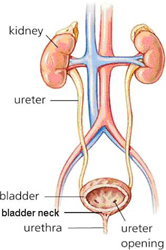Anatomy And Physiology

The bladder is pear shaped, becoming more oval as it fills with urine. The kidneys form the urine, which passes through the ureters to the bladder for storage prior to elimination.
The bladder opens into the urethra at the neck of the bladder. The wall of the bladder is composed of 3 layers:
- Outer layer of loose connective tissue, containing blood and lymphatic vessels and nerves
- Middle layer, consisting of a mass of interlacing smooth muscle fibres and elastic tissue – this is called the detrusor muscle
- Inner layer composed of transitional epithelium
When empty, the bladder inside is arranged in folds (rugae), which disappear as the bladder fills with urine. The bladder can stretch and distend to a normal capacity of 500-600mls. The bladder acts as a storage reservoir for urine. Micturition is the process by which urine is expelled from the bladder.
At the base of the bladder is the bladder neck, which leads into the urethra, through which urine is expelled to the external environment. The bladder neck and the proximal urethra (nearest part) are supported by pubourethral ligaments and the levator ani muscles of the pelvic floor. The anatomy of the male urethra and female urethra vary considerably in both length and structure. The first 3-4cm of the male urethra passes through the prostate gland, which lies below the bladder and is attached to its base.
